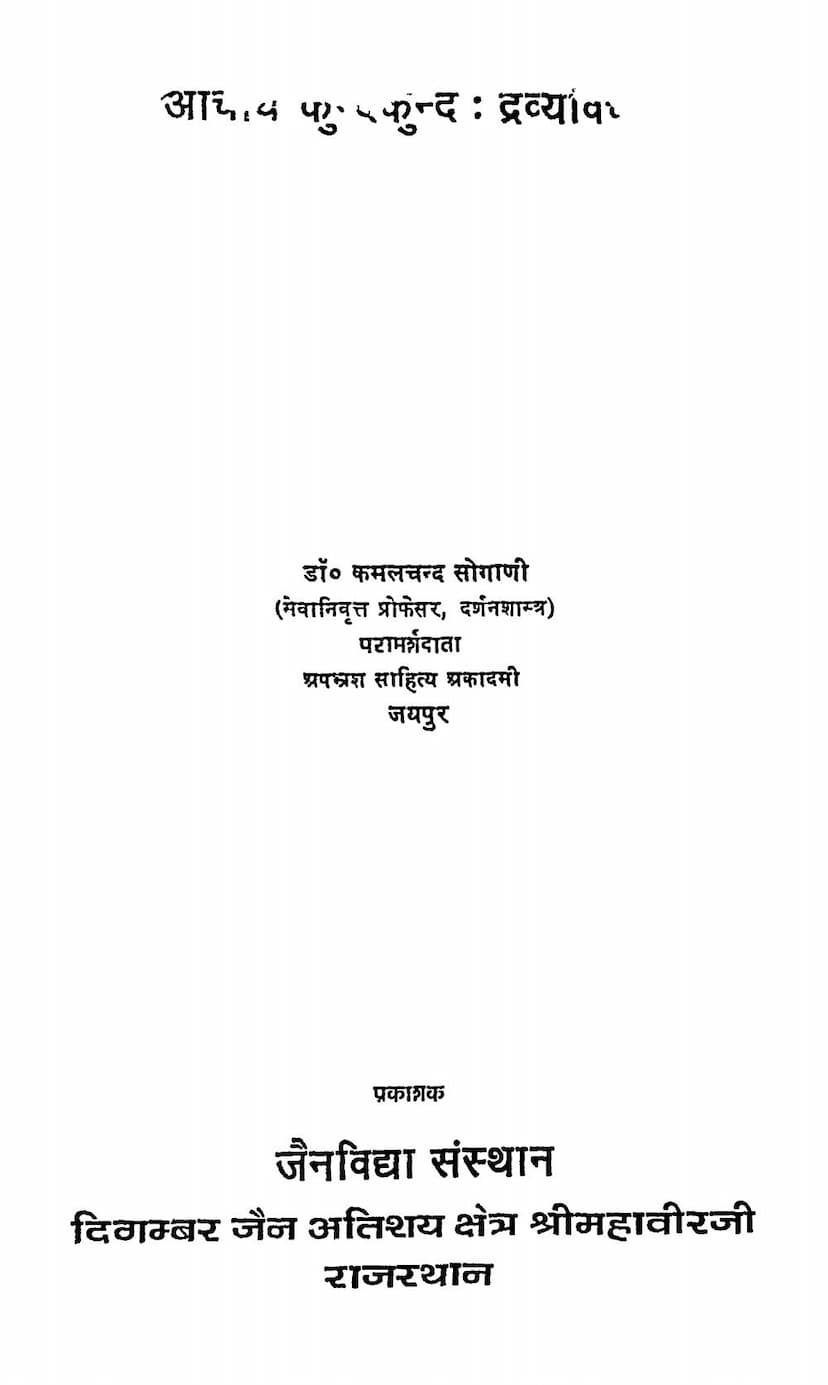Aacharya Kundakunda Dravyavichar
Added to library: September 1, 2025

Summary
This document is a comprehensive summary and analysis of Acharya Kundakunda's "Dravyavichar" (Treatise on Substances) by Dr. Kamalchand Sogani, published by Jain Vidya Sansthan. The book delves into the fundamental principles of Jain philosophy, particularly the concept of "dravya" (substance or reality).
Here's a breakdown of the key themes and content:
Core Jain Philosophical Concepts:
- Dravya (Substance): The book begins by defining dravya as that which is sat (real or existent). A dravya is characterized by its simultaneous creation (utpad), destruction (vyay), and permanence (dhrauvya). It is the substratum of qualities (guna) and modifications (paryaya). Kundakunda's central thesis is that dravya is the fundamental reality, and without qualities and modifications, a dravya cannot be grasped.
- Six Dravyas: The text systematically explains the six fundamental substances in Jainism:
- Jiva (Soul/Living Being): The only sentient substance, characterized by consciousness (chetana), knowledge (jnana), and perception (darshana). The soul is eternal and unchanging in its essence, though its worldly manifestations (paryaya) vary.
- Pudgala (Matter): The non-sentient substance that possesses form, taste, smell, and touch. It is the cause of the physical world and includes everything from subtle atoms (paramanu) to gross combinations (skandha).
- Dharma (Principle of Motion): A non-sentient substance that aids the movement of jiva and pudgala. It is formless and pervasive.
- Adharma (Principle of Rest): A non-sentient substance that aids the stationary state of jiva and pudgala. It is also formless and pervasive.
- Akasha (Space): The non-sentient substance that provides space for all other substances. It is infinite and formless.
- Kala (Time): The non-sentient substance responsible for the modifications and changes in other substances. It is also formless.
- Paryaya (Modifications/States): The text distinguishes between two types of paryaya:
- Vyanjana Paryaya (External Modification): Changes in the gross form or manifestation of a substance, like a soul taking birth in different life forms (human, divine, etc.).
- Artha Paryaya (Internal Modification): Subtle, moment-to-moment changes in the qualities of a substance, like the taste of milk turning sour.
- Nitya-Anitya (Eternal-Non-eternal): The book emphasizes that dravya is eternal in its essence (dravya-guna) but non-eternal or changing in its modifications (dravya-paryaya). This concept of dravya being both permanent and transient is central to Jain metaphysics.
- Nayas (Standpoints): The work highlights the importance of different nay's (standpoints) in understanding reality.
- Nishchaya Naya (Real or Ultimate Standpoint): Focuses on the pure, essential nature of dravya, free from external influences and modifications. In this view, the soul is pure consciousness, unaffected by karma.
- Vyavahara Naya (Conventional or Empirical Standpoint): Deals with the empirical reality and worldly classifications, acknowledging the soul's engagement with karma and its resultant experiences.
Key Themes Elaborated:
- The Nature of the Soul (Jiva): The book explains that the soul is the cause of both happiness and suffering. It is inherently capable of knowledge and perception but becomes entangled with matter through passions (kashayas) and karma. The soul is described as being the size of the body it inhabits.
- Classification of Souls: Souls are classified based on the number of senses they possess (one-sensed, two-sensed, etc., up to five-sensed beings). Spiritually, souls are categorized as bahiratma (external-minded), antarātmā (internal-minded), and paramātmā (supreme soul or liberated soul).
- Pudgala's Properties and Bonding: The text details how pudgala atoms combine based on their inherent qualities of stickiness (snigdha) and dryness (ruksha), leading to the formation of various substances. It describes how atoms with similar or complementary properties bond.
- The Function of Dharma and Adharma: The book clarifies that dharma and adharma are not ethical concepts but principles that facilitate motion and rest, respectively, for souls and matter.
- The Nature of Space and Time: Akasha provides space for all dravyas, while Kala facilitates their temporal modifications.
- The Process of Karma and Liberation: The book elaborates on how actions (karma) lead to states of consciousness (knowledge, intention, and fruit). Liberation (moksha) is achieved by eradicating passions and karmic impurities, leading to the soul realizing its pure, inherent nature of infinite knowledge, perception, bliss, and power.
- The Importance of Pure Conduct (Charitra): Charitra (conduct) is identified as dharma (righteousness) and is closely linked to equanimity (samata). True spiritual progress involves moving beyond the external world and focusing on the self, shedding attachment and aversion.
Structure and Methodology:
The book is a compilation of significant verses (gathas) from various works of Acharya Kundakunda, such as Panchastikaya, Pravachanasara, Samayasara, Vvoharasara, and Ashtapahuda. Dr. Sogani has meticulously selected these verses to present a coherent understanding of Kundakunda's dravyavichar.
A unique feature of this publication is the inclusion of:
- Original Prakrit Gathas: The authentic verses from Kundakunda's works.
- Grammatical Analysis: Detailed breakdown of the Prakrit words, their roots, and grammatical forms. This aids readers in understanding the nuances of the language.
- Hindi Translation: Clear and accurate translations of the verses, aiming to be faithful to the original meaning and accessible to a wider audience.
Overall Purpose:
The book aims to:
- Present Acharya Kundakunda's profound insights on the nature of reality (dravya) in a concise and understandable manner.
- Provide a scholarly resource for students and researchers of Jain philosophy and Prakrit literature.
- Educate readers on the fundamental principles of Jainism, emphasizing the path to spiritual liberation through self-realization and ethical conduct.
- Make the complex philosophical concepts of Kundakunda more accessible by offering grammatical analysis and clear translations.
In essence, Dr. Kamalchand Sogani's "Acharya Kundakunda: Dravyavichar" is a significant contribution to Jain scholarship, offering a structured and detailed exploration of Acharya Kundakunda's seminal teachings on the fundamental substances of existence.